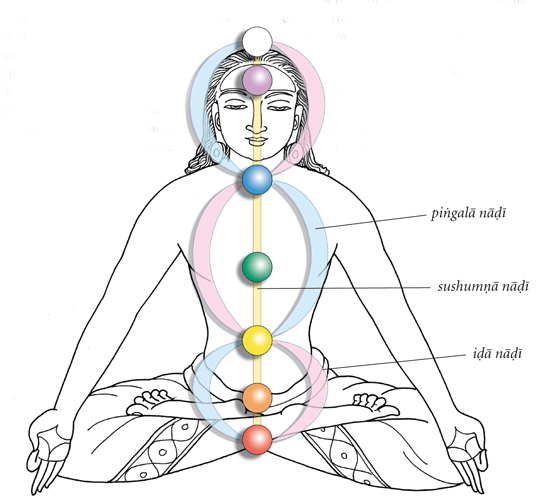Seven Chakras Above: The most subtle of the chakras lie above and within the crown chakra at the top of the head. Buddhist literature cites thirty-two chakras above. Āgamic Hindu tradition delineates seven levels of the rarified dimensions of paranāda, the first tattva and the highest stratum of sound. They are: vyāpinī, vyomāṅga, anantā, anāthā, anāśṛitā, samanā and unmanā. The higher chakras have been experienced by a rare few as a conglomerate of nāḍīs, spiritual nerve currents, which when stimulated and developed by many samādhi experiences, slowly descend into the mental and astral bodies, effecting a permanent transformation of the entire being.§
7. Sahasrāra सहस्रार Illumination, Godliness. The spiritual mountaintop, pinnacle of light, energy and consciousness. Aham Brahmasmi, “I am That,” is unveiled. Here liberated ones abide in communion with the Self. Meaning: “thousand-petaled.” Location: top of the cranium. Deity: Śiva. Śakti: Nirvāṇaśakti. Color: gold. Petals: 1,008. Plexus: pituitary. Plane: Satyaloka.§
6. Ājñā आज्ञा Divine sight. Sensitives and clairvoyants reside in the pastel petals of this refined realm, with access to many levels of superconsciousness and inner worlds of light. Meaning: “command.” Location: between the brows. Deity: Ardhanārīśvara. Śakti: Hākinī. Color: lavender. Vehicle: swan. Petals: two. Plexus: cavernous. Plane: Tapoloka.§
5. Viśuddha विशुद्ध Divine love. Here, limitless love wells up, a vision of all souls as brothers and sisters and all things as sacred. Selfless souls, exceptional artists and mystical poets reside here. Meaning: “purity.” Location: throat. Deity: Sadāśiva. Śakti: Śākinī. Color: smokey purple-blue. Vehicle: peacock. Petals: sixteen. Plexus: pharyngeal. Element: ether. Plane: Janaloka.§
4. Anāhata अनाहत Direct cognition. Those who reach this realm, with their delicate, penetrating insight into many fields of activity and knowing, are mankind’s guides, counselors, mentors and problem solvers. Meaning: “unsullied.” Location: heart. Deity: Īśvara. Śakti: Kākinī. Color: smokey green. Vehicle: deer. Petals: twelve. Plexus: cardiac. Element: air. Plane: Maharloka.§
3. Maṇipūra मणिपूर Willpower. This is the hub of willpower. Accomplished men and women perform at high levels mentally and physically when living in this center of energy, discipline and endurance. Meaning: “Jewelled city.” Location: solar plexus. Deity: Mahārudra Śiva. Śakti: Lākinī. Color: yellow-amber. Vehicle: ram. Petals: ten. Plexus: epigastric or solar. Element: fire. Plane: Maharloka-Svarloka. §
2. Svādhishṭhāna स्वाधिष्ठान dwelling place and the pragmatist’s refuge. Meaning: “one’s own place.” Location: lower abdomen. Deity: Vishṇu. Śakti: Śākinī. Color: reddish orange. Vehicle: crocodile. Petals: six. Plexus: prostatic. Element: Water. Plane: Bhuvarloka.§
1. Mūlādhāra मूलाधार Memory-time-space. The abode of memory, the foundation of all human knowledge, this center is also the seat of our basic instincts of survival, sexuality and others. Meaning: “foundation.” Location: base of spine. Deity: Gaṇeśa and Brahmā. Śakti: Ḍākinī. Color: red. Vehicle: elephant. Petals: four. Plexus: sacral or pelvic. Element: Earth. Plane: Bhūloka.§
Seven Chakras below the Mūlādhāra§
1. Atala अतल Fear and lust. As awareness slips below the mūlādhāra into fear, indecision stymies ambition and a licentious lifestyle dulls the prāṇic sheath. Meaning: “without bottom.” Plane: Put.§
2. Vitala वितल Raging anger. Dark red-black streaks emblazen the aura when awareness enters this furnace of instinctive fire and then injures others. Meaning: “region of the lost.” Plane: Avīchi.§
3. Sutala सुतल Retaliatory jealousy. Wanting what others have and preoccupation with what one is not gnaws at the mind, instilling ill-will. Meaning: “great lower region.” Plane: Saṁhāta.§
4. Talātala तलातल Prolonged confusion. Perversions replace natural joys. Negative karmas compound and stiffen the flow of awareness. Reason warps. Meaning: “under the bottom level.” Plane: Tāmisra.§
5. Rasātala रसातल Selfishness. An imprisoning veil of “me” and “mine” blinds the natural instinct to care for others. Every action is for personal gain. Meaning: “lower region of moisture.” Plane: Ṛijīsha.§
6. Mahātala महातल Consciencelessness. Blindness to higher impulses prevails. Guilt, compunction, even fear, are foreign. Criminality is life. Meaning: “greatest lower region.” Plane: Kuḍmala.§
7. Pātāla पाताल Malice and murder. A virtual hell of hate, hurting, killing for its own sake without remorse. Reason rarely reaches this region. Meaning: “lower region of wickedness.” Plane: Kākola.§
Iḍā, Piṅgalā and Sushumṇā §
Illustrated here are the three main nāḍīs: iḍā, piṅgalā and sushumṇā, psychic nerve currents through which prāṇa flows from the central source, Śiva. Iḍā and piṅgalā intertwine the spinal column (shown diverging far outside the sushumṇā for sake of illustration). They begin at the mūlādhāra chakra, cross at the maṇipūra and the viśuddha chakras and meet at the sahasrāra. Iḍā nāḍī, pink in color and feminine in nature, is the channel of physical-emotional energy. It flows downward, ending on the left side of the body. Piṅgalā nāḍī, blue in color and masculine in nature, is the channel of intellectual-mental energy. It flows upward, ending on the right side of the body. Sushumṇā, the major nerve current, pale yellow in color, passes through the spinal column from the mūlādhāra chakra at the base to the sahasrāra at the crown of the head. It is the channel of kuṇḍalinī. Through yoga, the kuṇḍalinī energy lying dormant in the mūlādhāra is awakened and made to rise up this channel through each chakra to the sahasrāra chakra. §
